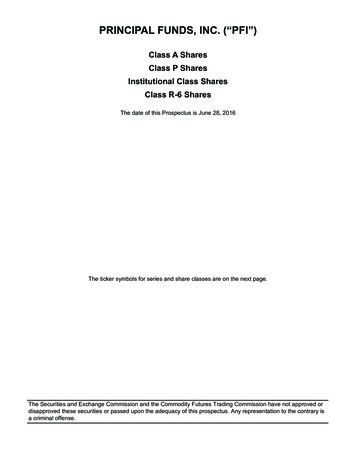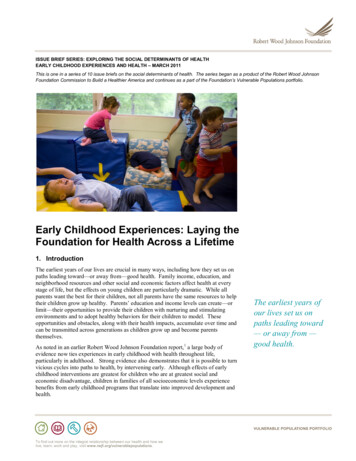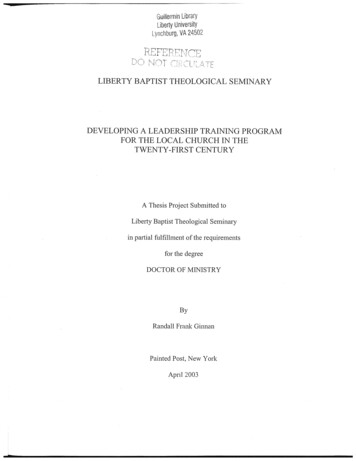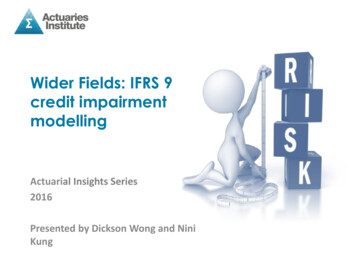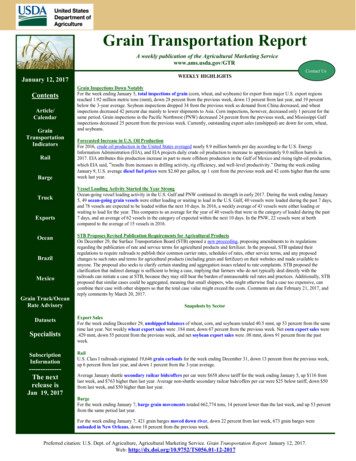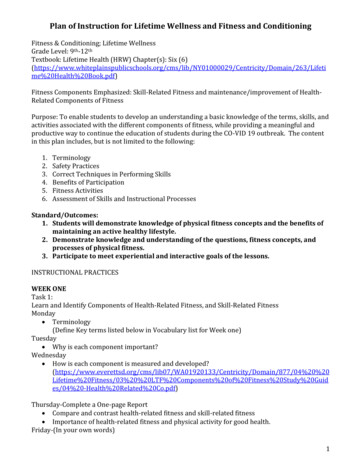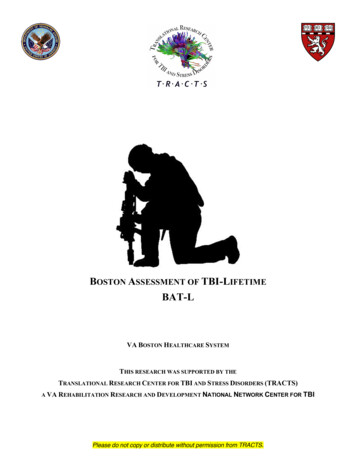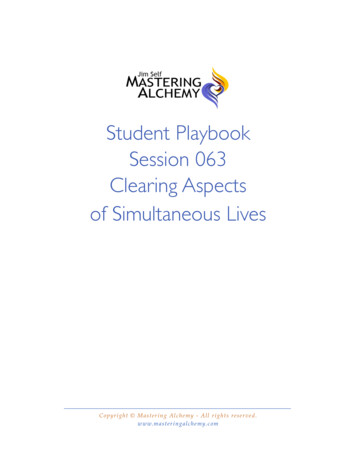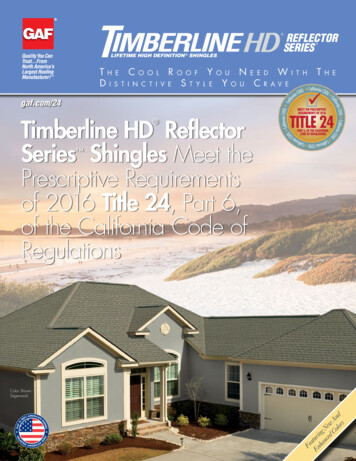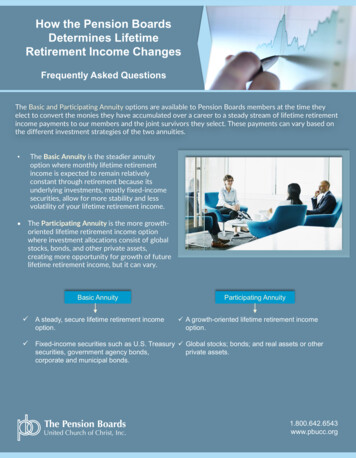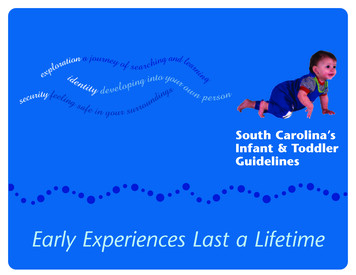
Transcription
South Carolina’sInfant & ToddlerGuidelinesEarly Experiences Last a Lifetime
The six developmental domains at the heart of school and life success.Physical HealthMotor DevelopmentPhysical health is optimal when safe healthpractices and nutrition are combined withnurturing and responsive caregiving. Protectingchildren from illness and injury, and providingthem with individually appropriate nutrition anda sanitary environment that reduces the risk ofinfectious disease, is important for all caregivers.Motor development is the increasing ability to useone's body to interact with the environment.Emotional DevelopmentLanguage & CommunicationDevelopmentEmotional development is the child's emergingability to become secure, express feelings,develop self-awareness and self-regulate.Language and communication development is theincreasing ability to communicate successfully withothers to build relationships, share meaning andexpress needs in multiple ways.Social DevelopmentCognitive DevelopmentSocial development is the child's emergingdevelopment of an understanding of self andothers, and the ability to relate to other peopleand the environment.Cognitive development is the building ofthinking skills.Early Experiences Last a Lifetime
Purpose Statement: Why are these guidelines important?Because early experiences last a lifetime and infancy is the morning of life.These guidelines are meant to be the critical first step in ensuring that all of South Carolina’s children, birth to three, haveresponsive, reciprocal and respectful care. It is our hope that, as a result of that care, children will be ready for school and for aproductive adulthood. There are 1,892 days from the time babies are born until they enter school. This 1,892 day journey isremarkable, complex and far reaching. Approximately 62,000 babies are born every year in South Carolina. Who they spend timewith and how they are cared for affects who they will become. These Infant and Toddler Guidelines are meant for three diverse yetcritically important groups of people in the lives of infants and toddlers: parents and families, providers and policy makers.Parents and FamiliesYou are your child’s first and best teacher. These guidelines aremeant to help you understand infant and toddler development.The guidelines include posters for each age range (birth-8 months,6-18 months and 16-36 months) and provide snapshots ofpotential milestones for each developmental domain (physicalhealth, emotional, social, motor, language & communication andcognitive development). If you want to learn more about whereyour child is developmentally in terms of a particular domain, youcan tab to that section of the document. Each domain hasguidelines with indicators and examples of behaviors that youmight see your child demonstrate across the three stages ofinfancy.ProvidersIn South Carolina, the majority of infants and toddlers are cared foroutside of their homes. Requirements for caring for children inSouth Carolina are minimal. These two facts make it imperative thatthose caring for our most valuable and vulnerable resource havethe knowledge they need to do this work well. When usedeffectively, the guidelines can assist programs and care teachers infocusing on early development and learning in order to supportand strengthen the developmental outcomes of the children theyserve.Policy makersIf South Carolina is genuinely committed to preparing its youngestcitizens for the challenges they will face in the future, it must adoptpolicies that support young children’s optimal growth anddevelopment. This commitment is important because we know thathigh quality infant and toddler programming increases children’schances for school success and increases the likelihood that today’syoungest citizens become tomorrow’s productive adults.What a responsibility! We have the opportunity to shapeexperiences that last a lifetime. Babies are ready for us, are weready for them?1
South Carolina’s Path to Adopting These Infant & Toddler GuidelinesSouth Carolina embarked on the process of developing Infant &Toddler Guidelines (ITG) in September, 2008. At that time the Infant/Toddler GuidelinesCommittee, led by Kerrie Welsh, Director of the South Carolina Program for Infant/Toddler Care Network (SC PITC), was first convened. In that firstmeeting the group identified a number of characteristics that would be essential for the guidelines South Carolina would eventually adopt.As it turned out, that meeting coincided with events that drasticallychanged the economic landscape of South Carolina and thecountry. The Infant/Toddler Leadership Team soon realized that,rather than "reinventing the wheel" they would be better stewardsof South Carolina’s limited resources if they could identify and buildon the sound work that had been done by another state. A subcommittee of the Infant/Toddler Guidelines Committee evaluated anumber of states’ Infant/Toddler Guidelines using a rubric that wasdesigned to assess how well each met the criteria identified by thecommittee as essential. These criteria are listed on the followingpage. The sub-committee identified Ohio’s Infant/ToddlerGuidelines as the document with the characteristics the GuidelinesCommittee had identified as essential. Characteristic of Ohio’sGuidelines that made them particularly appealing were the fact thatthey are based on the WestEd Center for Child & Family Studies’Program for Infant/Toddler Care (PITC), were developed inpartnership with PITC, and support South Carolina’s long-timeinvestment in PITC.The Infant/Toddler Guidelines Leadership Team initiatedconversations with leaders of Ohio’s Infant/Toddler initiative. Wewere thrilled when they generously granted us permission to useand adapt their fine work. This collaborative approach allows us todevote more of our resources to supporting caregivers inunderstanding and utilizing the guidelines through training andtechnical assistance. Caregivers who have a clear understanding ofthe Infant/Toddler Guidelines, and are supported in integratingthem into their everyday practice, will be better prepared toprovide responsive care that is developmentally appropriate and ismost likely to support young children’s optimal development.It is from this foundation that we present to you South Carolina’sInfant & Toddler Guidelines, which have been adapted from Ohio’sInfant/Toddler Guidelines.AcknowledgementsWe would like to thank Jamie Gottesman, Ohio Bureau of ChildCare & Development and Holly Scheibe, Ohio Child Care Resource& Referral Association who have graciously worked with SouthCarolina’s Department of Social Services, ABC Child Care QualityProgram, South Carolina Program for Infant/Toddler Care, and theUniversity of South Carolina to make this collaboration possible. Wewould also like to thank Ohio’s Infant & Toddler Guidelines WritingTeam for the contribution they have made to South Carolina’syoungest citizens.2
Criteria for South Carolina’s Infant/Toddler Guidelines SelectionThese criteria were used to selectInfant/Toddler Guidelines that reflect the values South Carolina recognizes as criticalto providing high quality care to infants and toddlers.wAge groups are divided so that they are broad enough toallow for normal variation in development and still narrowenough to have meaning.wGuidelines emphasize the importance of very youngchildren’s relationships with adults as the foundation fortheir learning.wLearning expectations for each domain reflect an accurateprogression of development.wwLearning expectations include observable indicators.Guidelines describe the importance of individualization ofcare for infants and toddlers by, for example, stressing theimportance of their home language and primarycaregiving.wLearning expectations, indicators, and examples are writtento describe a variety of goals and ways of achieving themthat are inclusive of South Carolina’s diverse cultural,ethnic, and linguistic populations.wGuidelines are evidence-based, relying on current andquality research.wGuidelines are formatted and designed so that caregiverscan easily use the guidelines in their classroom.wGuidelines are inclusive of all children, demonstrating thatinfants and toddlers with disabilities and special needs areexpected to learn and to be served in the typical child caresettings.3
South Carolina’s Infant & Toddler Guidelines CommitteeMarcia BaconDirector of Early Care and EducationRichland County First StepsBillie Green-SmithDirectorSC Child Care Resource and Referral NetworkAnn PfeifferProfessional Development CoordinatorSC Center for Child Care Career Development*Angela BaumAssistant ProfessorUSC College of EducationYvonne & Schuyler Moore Child Development Research CenterSandra HackleyProgram DirectorEarly Childhood DevelopmentMidlands Technical CollegeBessie Sanders-GordonInfant/Toddler SpecialistSC PITC NetworkInfant/Toddler SpecialistSC State Based Head Start T/TA OfficeLeigh BolickDirectorChild Care ServicesSouth Carolina Department of Social Services*Beverly HunterABC Program Monitoring ManagerSouth Carolina Department of Social ServicesGay Clement-AtkisonDirector (Retired)ABC Special Needs ProgramFernanda DasilvaInfant/Toddler SpecialistSC PITC NetworkMickie JenningsDirector of Educational ServicesSunshine House Child Care CentersVenie JonesManagerS.H.A.R.E. Head Start & Early Head StartDonna DaviesTraining CoordinatorSC Center for Child Care Career Development*Herman KnopfAssistant ProfessorUSC College of Education,Yvonne & Schuyler Moore Child Development Research CenterPam DinkinsProgram ManagerCentral Carolina Technical CollegeKrista KustraConsultantSC First StepsRebecca DixonCertified Director- Cohort 1Parents as TeachersLinda LawsonProgram ManagerSpartanburg Regional Ida Thomson Child Development ProgramInfant/Toddler SpecialistSC PITC NetworkEkky FossDirectorEarly Head Start- Spartanburg*Nancy FreemanAssociate ProfessorUSC College of Education,Yvonne & Schuyler Moore Child Development Research CenterSusan GrahamTraining DirectorSC First Steps Centers of Excellence InitiativeCynthia GrahamDirectorSumter District 17- Early Head StartRobin McCantsEarly Childhood SpecialistSouth Carolina Department of Education Literacy and EarlyLearningEdna SmithOwner/DirectorMiss Eddie’s Child Development CenterMelissa StarkerParentChild in Infant/Toddler ProgramNur TanyelAssistant ProfessorEducation DepartmentUniversity of South Carolina, UpstateMyrna TurnerProgram MonitorABC Child Care ProgramSouth Carolina Department of Social ServicesPat VoelkerDepartment ChairEarly Childhood ProgramSpartanburg Community College*Kerrie WelshDirectorSC PITC NetworkMelissa WindhamDirectorGreenville YWCA Child Care ProgramTeresa McKinneyEarly Head Start Program SpecialistSpartanburg County First StepsRosemary NewDirectorInfant/Toddler ProgramGreenville First Baptist Church Weekday School*Leadership Team4
Birth to Eight MonthsDuring the early days and months of my life, I am primarily focusedon security. In essence, I am learning about what I can expectfrom life.When I feel discomfort, I cry. Someone comes to help me. Shehelps me — when I’m hungry — when I’m tired — when I’m outof sorts. When she helps, I feel everything is going to be all right,and I can relax. I like to look at her face. I like to listen to her voice.I feel her warmth. I feel the care she gives me — time after time.I feel content. I coo. As I get older, I smile when I see her face andhear her voice. I try to make the sounds she makes. I try to movemy arms the way she does. I learn so much from her. Her responsesmake me feel so good. I’ve learned to expect her to come whenI call.I often don’t have to cry. She knows what I need by watching meand by listening to me. She puts me in places where I can movearound. That’s exciting! I keep learning how to move my body —my head, my arms, my legs, my whole body. I can count on her tohelp me when I need help and to play with me when I’m ready toplay. I feel great knowing she is with me when I need her.All of this is very important! I have to feel emotionally secure inorder to have the confidence to learn new things. My level ofconfidence will influence how I approach the opportunities comingmy way. I know it seems like a long way off, but my ability to takechances and adapt to change will allow me to be successful in bothschool and in life.55
Health PracticesSouth Carolina’s Infant & Toddler GuidelinesBirth to Eight lopmentMotorDevelopmentI need to receivecheck-ups at birth andat one, two, four andsix months of age.I may stop cryingupon seeing a faceor hearing a voice.AttachmentExpressionof EmotionI may smile at mycaregiver when(s)he rocks me andsings to me.I may babble backand forth with acaregiver.Oral HealthI may notexperience distresswhen my mommyleaves the room.Self-AwarenessAttachmentExpression ofSocial BehaviorI may roll from frontto back or backto front.I may grasp mymother's fingerwhen she places itin my tiny palm.Small MuscleComprehendingLanguageLanguage &CommunicationDevelopmentI may watch mygrandmother's faceas she speaks to me.I may snuggle happilywith my special blanketwhen I find it in a pileof fresh laundry.Discoveriesof InfancyPositiveNutritional StatusI will double mybirthweight by thetime I reach four tosix months of age.EmotionalSelf-RegulationI may calm myselfwhen I'm upset bysucking on myfingers or hand.I may smile and lightup when my bigbrother comes totalk to me.I may match thefacial expressions ofan adult.Large MuscleCognitiveDevelopmentI will display drooling,irritability and soregums caused bytooth eruption.I may use gesturesor expressions toindicate my wants,needs or feelings.ExpressingLanguageAwareness ofSocial BehaviorOral-MotorI may use my tongueto move food insidemy mouth.SocialCommunicationI may gaze at mycaregiver duringa feeding.I may cuddle andlook at my caregiver'sface while I ambeing read to.Early LiteracyAttention &PersistenceI may show moreinterest in a new toythan an old one.w
Six to 18 MonthsDuring this middle period of my development, I am now primarilyfocused on exploration. Get ready, because I am ready to moveout. In essence, I am learning how things in the world work,including myself.When I know where my caregiver is, I feel safe. I feel I can moveaway from her to explore things. Not too far — I stay close enoughso I can get back to her quickly. That’s what I do if something scaryhappens, or if I feel sad or if I feel like cuddling. That feels good.But after a while, I want to explore some more. I roll my body. Ialso creep and crawl. Eventually I figure out how to sit up, pull tostanding, take a step — and walk! I like to fiddle with things, overand over again. It’s fun to see how things work. I keep makingsounds my caregiver makes. I discover that each sound has adifferent meaning. When I say, “Dada,” he smiles.When I say, “Mama,” she smiles. I love when someone looks at methat way. When I point at something, my caregiver says what it is.I point and point and point. That’s one of the ways I learn. I do thiswith books too. I look at things with my caregiver. I like to listen toher. I like when she listens to me. Most of all, I like to be in a placewhere I can move to my heart’s delight, where I can play withanything I can reach and where I can easily see my caregiver’ssmiling eyes.All of this is very important! My drive to explore the world andfigure things out helps me build knowledge and get ready for theworld of ideas. I know it seems like a long way off, but my beingintellectually curious and motivated to learn will help me besuccessful in both school and in life.7
Health PracticesSouth Carolina’s Infant & Toddler GuidelinesSix to 18 MonthsPhysicalHealthEmotionalDevelopmentI need to receivecheck-ups at nine,12, 15, and 18months of age.I may cry out orfollow my momwhen she leavesthe gnitiveDevelopmentI may show affectionfor my caregiver byhugging her.PositiveNutritional StatusI may try to controlmy expression ofdistress by biting mylip or hugging myself.I may begin toidentify parts ofthe body.EmotionalSelf-RegulationSelf-AwarenessI may roll a ballwith a peer.AttachmentExpression ofSocial BehaviorI may get into and outof a sitting positionindependently.I will triple mybirthweight by thetime I reach 12 to18 months of age.Oral HealthI may display anxietywhen an unfamiliaradult gets tooclose to me.Large MuscleLanguage &CommunicationDevelopmentExpressionof EmotionI will display eruptionof the lower and uppercentral and lateral incisors,canines and first molars.I may show anxietywhen my dadleaves.Awareness ofSocial BehaviorSmall MuscleI may drink from asippy cup.I may put a blockback in the plastic bin.Oral-MotorI may reach for mybottle when I amasked, “Do youwant your bottle?”I may shake my headback and forth andsay, “no” when I don’twant to do something.ComprehendingLanguageExpressingLanguageI may get myself stuckin a tight spacewhen exploring.I may fill a bucketwith sand orstack blocks againand again.Discoveriesof InfancyAttention &PersistenceSocialCommunicationI may play“peek-a-boo”with my aunt.I may follow mymom’s gaze to lookat a picture in a book.Early Literacyw
Sixteen to 36 MonthsDuring this final stage of infancy, it is all about ME. I have a senseof who I am and how I am connected to others. In essence, I amlearning to make choices, and it can be difficult sometimes for meand for you.I feel powerful. I can run. I can do so many things. I know what’smine and make sure other people do, too. I like to be in chargeand do things by myself. If someone tells me what to do, I oftensay, “No.” But sometimes I don’t feel so big. I can get out of sortsand be quite loud. I may need help. I may need comfort. I mayneed to know what I’m allowed to do — and what I’m not allowedto do. Then I feel big again and am excited about everything I cando. I know where I belong, who I am and who my family is. I usemore and more words to express myself. As I get older, I ask alot of questions. I look at books and listen to stories. I talk with mycaregiver about books. Singing and rhyming games are a lot offun. I think about ideas all the time.When I try to solve a problem, sometimes an idea just pops in myhead. I pretend to be different people — and animals, too. I pretendwith other children. We play with dress-up clothes, kitchen utensils,puppets — just about anything. Playing with other children isgreat! I often think about one or two or three special people.It may be my mom, my dad, my grandma or grandpa, or mycaregiver in child care. When I think about someone I feel closeto, I feel good. Even if they are not with me, I know that personwill take care of me. I feel that person loves me. That’s the bestfeeling of all!All of this is very important! I have to know myself before I canlearn how to get along with others and to appropriately expressmyself when I’m frustrated. I know it seems like a long way off,but my ability to communicate and interact positively with peersand adults who will one day be colleagues and supervisors, alongwith my ability to negotiate conflict, will help me be successful inboth school and life.9
Health PracticesSouth Carolina’s Infant & Toddler GuidelinesSixteen to 36 lopmentI need to receivecheck-ups at 24 and36 months of age.I may hide my facein my hands whenfeeling embarrassed.AttachmentExpressionof EmotionI may say, "I go toschool, Mama goesto work," after mymom drops me offin the morning.I may walk up anddown stairs, alternatingmy feet, one oneach step.Large MuscleLanguage &CommunicationDevelopmentCognitiveDevelopmentI may point to myshoes or socks when mycaregiver asks, “Whereare your shoes?”ComprehendingLanguageI will gainapproximately4.5 to 6.5 poundsper year.PositiveNutritional StatusOral HealthI may gesture for onemore hug as mydaddy is leavingfor work.AttachmentMotorDevelopmentI will display eruptionof the lower andupper lateral incisors,canines and first andsecond molars.Self-AwarenessI may point tomyself in a familyphotograph.I may talk on the phoneand walk around likeI've seen my mommydo at home.Expression ofSocial BehaviorAwareness ofSocial BehaviorOral-MotorI may make snips in apiece of paper withchild-sized scissors.I may drink from anopen cup, usuallywithout spilling.I may begin to say,“bottle” insteadof “baba” whenwanting a drink.EmotionalSelf-RegulationI may practice being agrown-up in my pretendplay by dressing up orusing a play stove.Small MuscleExpressingLanguageI may reenactemotional events inmy play in order togain mastery.I may say “please”when I’m askingfor something.SocialCommunicationI may useeating utensils.I may engage insolitary play for ashort time.Discoveriesof InfancyAttention &PersistenceI may draw a circleand a straight lineafter watchingsomeone else do it.Early Literacyw
Physical HealthBabies need good health and nutrition right from the start. This isessential in laying the foundation for a baby’s optimal growth anddevelopment. Infants and toddlers depend on their caregivers tomake healthful choices for them. They also need adults to helpthem learn how to make good choices for themselves.Physical health affects functioning in all the other domains.This point becomes clear when a child’s health or well-being iscompromised. For example, a child who is chronically ill may notbe able to learn through active exploration and movement. Or achild who is poorly nourished may not attend to learning. Frequentear infections may hinder a child’s ability to communicate and learnlanguage. A child exposed to violence may not know how to formpositive social relationships. Each of these negative conditions canhave lifelong consequences.Frequent well-child visits allow health professionals to monitor thechild’s physical health, behavioral functioning and overall development.These visits create opportunities for giving age-appropriate guidanceto parents. In addition, health professionals should screen youngchildren for common concerns, including lead poisoning, hearingand vision problems, behavior concerns, communication disordersand general development (language, cognitive, social, emotionaland motor domains). Screening is important because the soonera child’s need for early intervention can be identified, the moreeffective that intervention is likely to be. Well-child care benefitsall children, including those with disabilities or other special needs.Each day, adults caring for babies can positively influence achild’s health and well-being. All infants and toddlers needregular health and physical exams, preventive care, screening,immunizations and sick care. They all should have a primaryhealth and dental care provider, regardless of their families’economic status. A primary provider facilitates timely andappropriate preventive and sick care.Physical health is optimal when safe health practices and nutrition are combined with nurturing and responsivecaregiving. Protecting children from illness and injury, and providing them with individually appropriatenutrition and a sanitary environment that reduces the risk of infectious disease, is important for all caregivers.11
Physical HealthGuideline: Health PracticesThe child will display signs of optimal health consistent with appropriate primary health care and caregiver health practices. Health care:The child will haveaccess to care from aprimary health provider,regardless of economicstatus and geographiclocation. Handwashing:The child will be exposedto and assisted withfrequent and properhandwashing.16 - 36 monthsBirth - 8 months6 - 18 monthsI need to receive regular check-upsthat include appropriate screenings,immunizations and guidanceabout my development.I need to receive regular check-upsthat include appropriate screenings,immunizations and guidanceabout my development.I need to receive regular check-upsthat include appropriate screenings,immunizations and guidanceabout my development. check-ups at birth and at one,two, four and six months of age. an evaluation within 48 - 72hours following discharge fromthe hospital, if I am a breast-fedbaby, to check my weight gain,to evaluate breastfeeding and toprovide caregiver encouragementand instruction. check-ups at nine, 12, 15 and 18months of age. check-ups at 24 and 36 monthsof age.I will receive handwashing atappropriate times. (If I am unableto stand or too heavy to holdsafely, my hands can be washedwith a damp paper towelmoistened with a drop of liquidsoap, and then wiped clean witha clean, wet, paper towel.)With assistance from a caregiver, Iwill wash my hands once I am ableto stand safely at the sink.With assistance from a caregiver, Iwill wash my hands once I am ableto stand safely at the sink. upon arrival at my child care setting. before and after eating. after diapering. before water play. after playing on the playground. after handling pets. whenever my hands are visiblydirty. upon arrival at my childcare setting. before and after eating. after diapering. before water play. after playing on the playground. after handling pets. whenever my hands arevisibly dirty. after diapering. before and after eating or havinga bottle.12
Physical HealthGuideline: Health PracticesThe child will display signs of optimal health consistent with appropriate primary health care and caregiver health practices.Birth - 8 months Diapering and toileting:The child will beappropriately diaperedor assisted with toiletingto prevent the spreadof illness.6 - 18 monthsI will be appropriately diapered.I will be appropriately diapered. changed when I give signs ofneeding to be changed, orchecked at least every twohours when awake, for signsof wetness or feces, andimmediately after waking. changed near a water source forquick handwashing to preventthe spread of infection. remain secure on a raisedchanging surface with mycaregiver's hand placed on me atall times. changed when I give signs ofneeding to be changed, orchecked at least every twohours when awake, for signsof wetness or feces, andimmediately after waking. changed near a water source forquick handwashing to preventthe spread of infection. remain secure on a raised changingsurface with my caregiver's handplaced on me at all times.16 - 36 monthsI will be appropriately diaperedand, toward the end of thisperiod, I may show signs thatI am ready to learn to usethe toilet. changed when I give signs ofneeding to be changed, orchecked at least every twohours when awake, for signsof wetness or feces, andimmediately after waking. changed near a water source forquick handwashing to preventthe spread of infection. remain secure on a raised changingsurface with my caregiver's handplaced on me at all times. show through gestures, expressions,body language or words that Iam about to urinate or have abowel movement. help with undressing myself. ask to use the toilet or pottychair.13
Physical HealthGuideline: Oral HealthThe child will display growth and behaviors associated with good oral health.Birth - 8 months6 - 18 months16 - 36 months Tooth eruption:The child will displayappropriate tootheruption.I will display appropriate tootheruption.I will display appropriate tootheruption.I will display appropriate tootheruption. drooling, irritability and soregums caused by tooth eruption. eruption of the lower and upperincisors. drooling, irritability and sore gumscaused by tooth eruption. eruption of the lower and uppercentral and lateral incisors, caninesand first molars. drooling, irritability and soregums caused by tooth eruption. eruption of the lower and upperlateral incisors, canines and firstand second molars. Oral health:The child will displaygood oral health.I will display good oral health.I will display good oral health.I will display good oral health. pink, firm gums. smooth, white teeth. pink, firm gums. smooth, white teeth. pink, firm gums. smooth, white teeth. Dental care:The child needs toreceive appropriatedental check-ups from adentist and appropriatedental treatment.I need to have my first oralexamination from a dentistwithin six months of the firsttooth eruption and by 12months of age.I need to have my first oralexamination from a dentistwithin six months of the firsttooth eruption and by 12months of age.I need to have my second oralexamination, as recommendedby my dentist, based on myindividual needs or risk of disease.14
Physical HealthGuideline: Positive Nutritional StatusThe child will display growth and behaviors associated with a positive nutritional status. Physical growth:The child will displayappropriate increasesin length, weight andhead circumference.16 - 36 monthsBirth - 8 months6 - 18 monthsI will display appropriate increasesin length, weight and headcircumference.I will display appropriate increasesin length, weight and headcircumference.I will display appropriate increasesin length, weight and headcircumference. lose about six percent of mybody weight immediately afterbirth because of fluid loss andsome breakdown of tissue, butthen regain my birthweightwithin 10 to 14 daysfollowing birth. double my birthweight by fourto six months of age. increase in length at the rateof approximately one inch permonth during the first sixmonths of life. grow without major deviationsin growth chart percentages. triple my birthweight by 12 to 18months of age. increase in length at the rate ofapproximately one-half inch permonth between six and 12months of age. grow without major deviationsin growth chart percentages. quadruple my birthweight by24 to 36 months of age. gain approximately 4.5 to 6.5pounds per year. increase in height at the rate ofapproximately 2.5 to 3.5 inchesper year. grow without major deviationsin growth chart percentages.15
Emotional DevelopmentBabies experience emotions right from the start. From their first cryof hunger to their first giggle of delight, their emotional experiencegrows. Youn
Program for Infant/Toddler Care (PITC), were developed in partnership with PITC, and support South Carolina's long-time investment in PITC. South Carolina's Path to Adopting These Infant & Toddler Guidelines The Infant/Toddler Guidelines Leadership Team initiated conversations with leaders of Ohio's Infant/Toddler initiative. We
